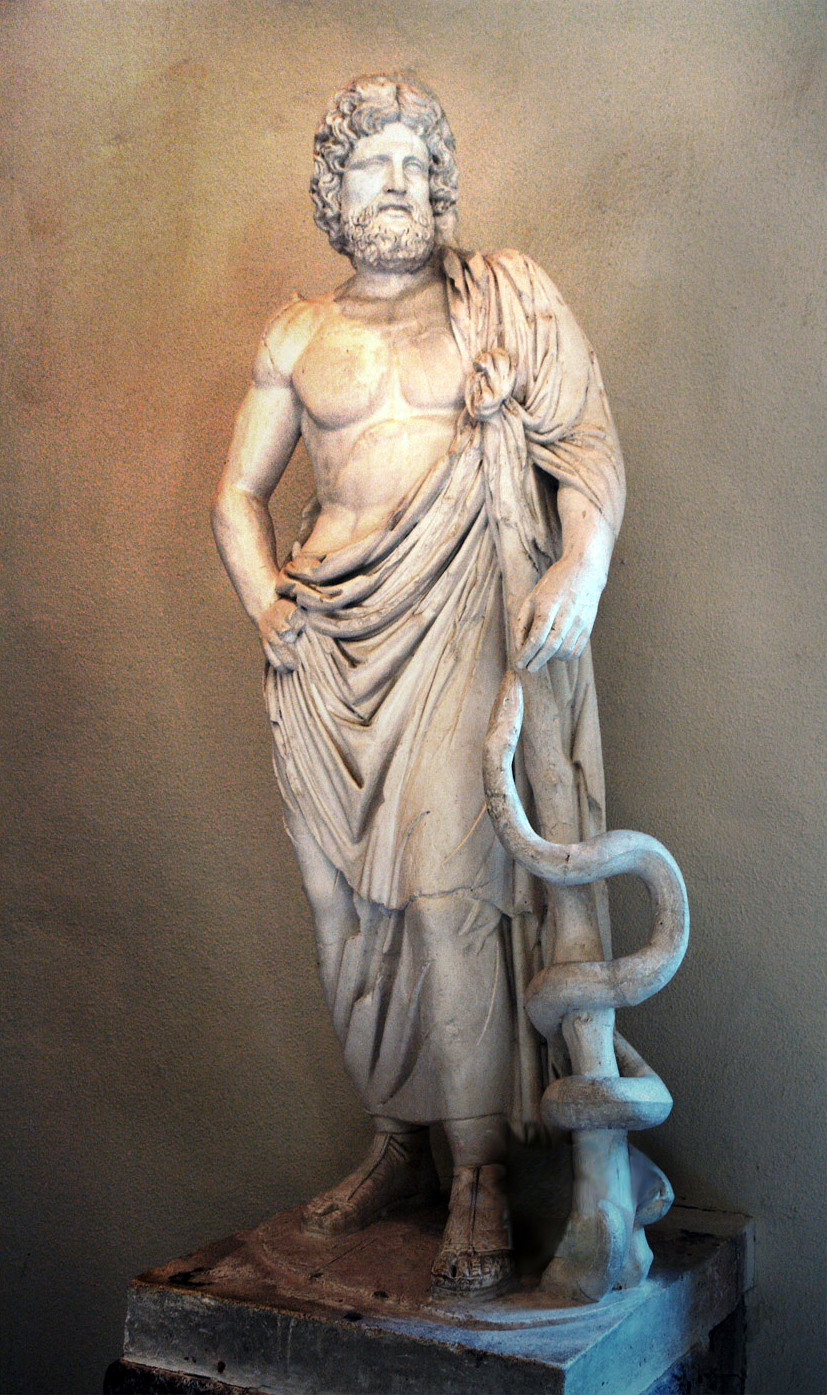“Although the snake is the symbol of medicine, globally, the world seems to have forgotten about snakebite...”
DR. KEN WINKEL, DIRECTOR OF THE AUSTRALIAN VENOM RESEARCH UNIT
A statue of Asclepius with the Rod of Asclepius clearly visible.
Snakes were not always associated with fear and loathing. There has been a long association between the serpent and the healing arts. If you look closely, you can find snakes adorning all sorts of medical symbols around the world from the Star of Life that adorns modern ambulances to the emblem of the World Health Organization and US Army Medical Corps. In ancient Greek mythology and religion, Asclepius was the god of medicine and of the healing arts and carried around a staff wrapped by a serpent.
The Star of Life is the symbol of modern emergency medicine services (EMS) and carries the Rod of Asclepius.
The emblem of the World Health Organization prominently features the Rod of Asclepius in the center.
There are several stories about the origin of the relationship between Asclepius and snakes. In one story, Asclepius killed a snake and watched as second snake arrived shortly after and fed herbs to the first one, reviving it. Asclepius then used the same medicinal herbs to revive a dead man. In another story, Asclepius learned the secrets of the healing arts from a serpent that whispered them into his ear. For hundreds of years, the cult of Asclepius maintained healing temples called Asclepeions where live non-venomous snakes would roam freely as the healers performed their rituals. This species is known today as the Aesculapian Snake (Zamenis longissimus, pictured below). Ancient physicians were known as Therapeutae of Asclepius. It is even said the Hippocrates, "father of medicine", began his career in one of these temples on the island of Kos, and Asclepius was even featured in the original text of the Hippocratic Oath:
"I swear by Apollo the Physician and by Asclepius and by Hygieia and Panacea and by all the gods…".
The real Aesculapian Snake (Zamenis longissimus), a harmless species found in Europe that was lived in the Asclepeion temples and was often used as part of the healing ceremonies. Photo by Felix Reimann from the Wikimedia Commons.
There are several intuitive reasons for the association between snakes and medicine. Ecdysis, the shedding of the skin that snakes perform many times during their lives, has been viewed as a symbol of rebirth or rejuvenation throughout the centuries. Likewise, snake venom has been used both as a harmful agent and as a healing agent in medicines, a process which continues to this day. In fact, many people owe their lives to snakes - several of the most common medications used to treat high blood pressure and heart attacks are molecules that were derived from the venoms of several different species of viper.
Many people associate the caduceus staff, a winged staff adorned by two intertwined serpents, as the symbol of modern medicine. However, this is historically incorrect and is believed to have originated in a misunderstanding by John Churchill, a British publisher of medical books, which was then followed by American medical publishing houses in 1902. The caduceus is actually the staff of Hermes, who was both the god of commerce and trade and the god of thieves! Not exactly the ideal association for a medical symbol, however, the misunderstanding of the role of each symbol remains widespread to this day.
Army Medical Corps patch adorned with the caduceus which traditionally represented commerce and negotiation rather than medicine.
The Asclepius Snakebite Foundation is composed of experts in medicine and herpetology, among other fields. Many of us are passionate about snake conservation and educating the public about the positive associations between snakes and humans and the beneficial roles they play in the environment. Snakes are exceptional pest-control agents and play a critical role in controlling the population of rodents and other small mammals that can ravage crops and spread highly-contagious diseases. Many of the great plagues in human history were caused by rodents, and the role that snakes play in preventing these pest species from causing harm is significant.
We chose Asclepius as the symbol of our foundation because we wanted to highlight the positive role of snakes. Even in the context of snakebite, it is worth remembering that the lifesaving medicine used to treat a snakebite comes from the snakes themselves! Antivenom cannot be made without the use of snake venom to immunize horses and sheep so they can develop the antibodies that are later extracted, purified, and turned into life-saving antivenom. Many life-saving medications taken by millions of people worldwide are made from snake venoms, and current research indicates that there are a great deal of molecules with incredible medical potential in snake venoms that we are just beginning to discover. Snakebite is responsible for hundreds of thousands of deaths and disabilities worldwide, but the venom from these snakes may one day be used to save millions of lives.
REFERENCES
1. Sacks, A. C., & Michels, R. (2012). Images and Asclepius. Caduceus and Asclepius: history of an error. The American Journal of Psychiatry, 169(5), 464–464. http://doi.org/10.1176/appi.ajp.2012.11121800
2. Vonk, F. J., Jackson, K., Doley, R., Madaras, F., Mirtschin, P. J., & Vidal, N. (2011). Snake venom: From fieldwork to the clinic. BioEssays, 33(4), 269–279. http://doi.org/10.1002/bies.201000117
3. Froman, C. R., & Skandalakis, J. E. (2008). One snake or two: the symbols of medicine. The American Surgeon, 74(4), 330–334. http://doi.org/10.1016/b978-0-444-87316-3.50019-7
4. Shetty, A., Shetty, S., & Dsouza, O. (2014). Medical Symbols in Practice: Myths vs Reality. Journal of Clinical and Diagnostic Research : JCDR, 8(8), PC12–4. http://doi.org/10.7860/JCDR/2014/10029.4730





